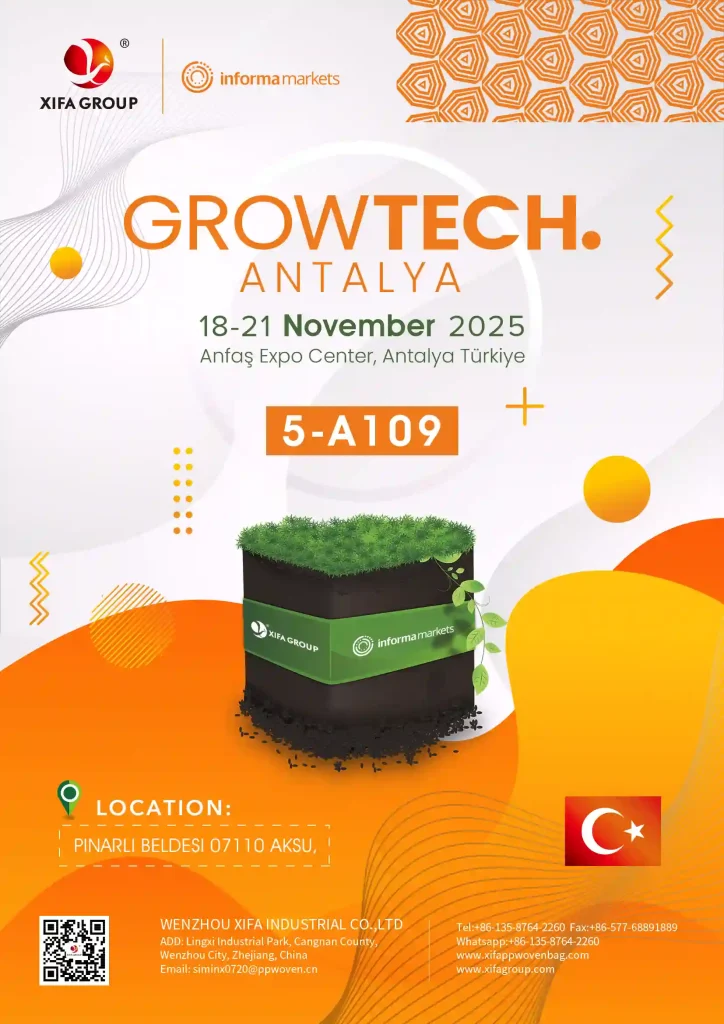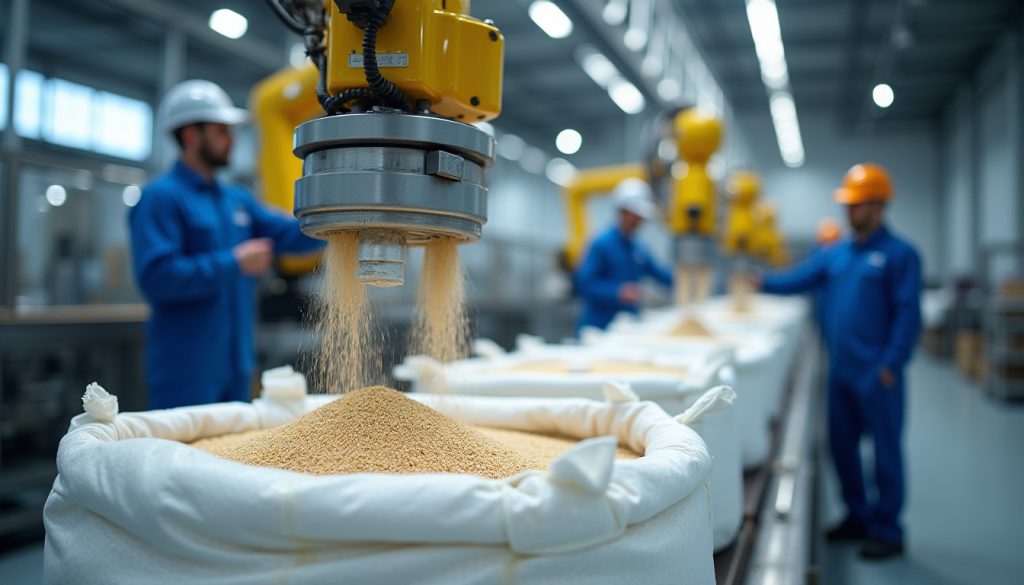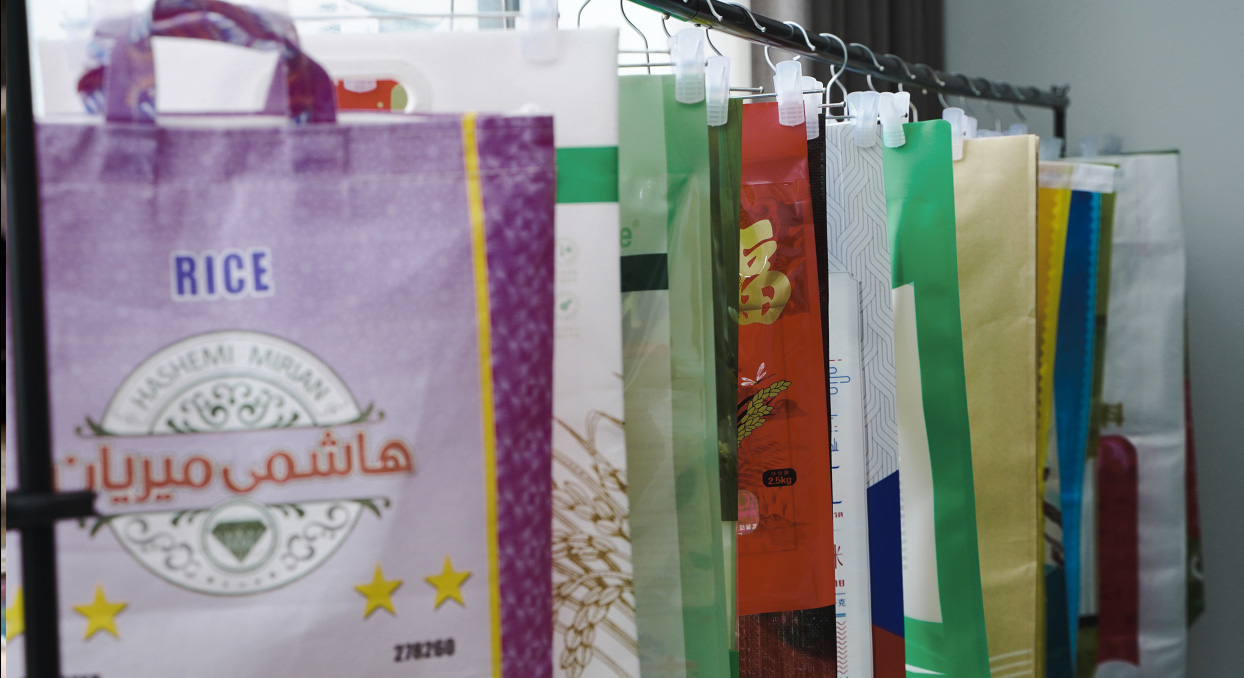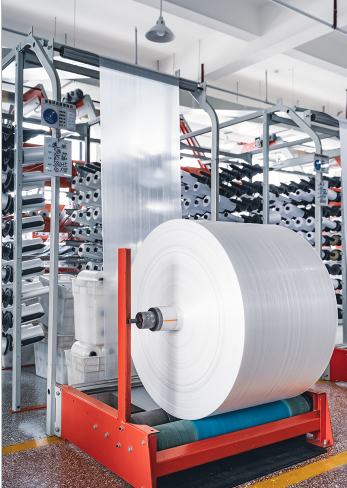

Une mesure précise des matériaux est essentielle dans des secteurs comme l'agroalimentaire, la chimie et la construction. Même de petites erreurs de poids peuvent entraîner des pertes, des défauts ou des problèmes de conformité. C'est pourquoi de nombreux fabricants utilisent la méthode de la perte de big bag dans les systèmes de dosage pondéral, qui allient manutention et pesage précis. Pour que ces systèmes fonctionnent correctement, le big bag doit être conçu en adéquation avec le doseur.
Dans cet article, nous explorons comment l’optimisation de la conception des big bags améliore la précision du dosage et la traçabilité, tout en réduisant les pertes de matériaux et le temps de travail.
Un doseur à perte de poids est un système de dosage automatisé qui mesure le flux de matière en suivant la perte de poids progressive d'une trémie d'alimentation ou d'un big bag. Il est largement utilisé pour alimenter les lignes de production en poudres, granulés et solides en vrac.
Dans le cas d'un doseur de big bag par perte de poids, le sac est suspendu à un système de cellules de charge. À mesure que le matériau est déchargé, le système surveille les variations de poids et ajuste le débit d'alimentation pour atteindre les valeurs cibles. Ce contrôle en boucle fermée est essentiel à la régularité des lots, en particulier sur les lignes automatisées.
Tous les big bags ne se valent pas. Pour une utilisation dans un système d'alimentation par perte de poids, certains facteurs de conception doivent être optimisés afin de garantir une détection fiable du poids et un flux de matière fluide.
La tare (poids à vide du sac) doit être uniforme pour tous les sacs utilisés. Des valeurs de tare incohérentes affectent la précision de la mesure du poids net. XIFA garantit des poids à vide cohérents grâce à des normes de fabrication strictes et une traçabilité par code QR, permettant un contrôle précis des stocks et du dosage.
Sacs FIBC Les évacuations coniques ou à bec verseur permettent un écoulement propre du matériau. Pour les poudres sujettes à la formation de ponts ou de trous de rat, XIFA peut intégrer des dispositifs d'assistance aux vibrations ou des raidisseurs pour améliorer l'écoulement.
Le tissu doit être suffisamment robuste pour supporter la charge du sac pendant la manutention, tout en étant suffisamment souple pour fonctionner avec des systèmes de pesée dynamique. XIFA utilise du polypropylène tissé avec une lamination BOPP en option pour plus de résistance, d'imprimabilité et de protection du produit.
Les dimensions des sacs doivent correspondre à celles du châssis ou de la trémie du doseur. XIFA propose des tailles de sacs personnalisées pour une compatibilité parfaite avec votre doseur à perte de poids, qu'il s'agisse de poudres de sablage, de produits chimiques fins ou de ciment.

Bien que les doseurs à perte de poids offrent un contrôle précis des matériaux, l'intégration avec des sacs en vrac peut présenter des problèmes sans une planification appropriée.
Des matériaux comme le dioxyde de titane ou la résine en poudre ont tendance à s'agglomérer, ce qui nuit à l'écoulement. Ceci entraîne des erreurs de pesée et des arrêts de l'alimentateur. Des solutions de conception de sacs comme chicanes internes ou des jupes anti-vibrations aident à éviter cela.
Si le flux de matière est irrégulier, le doseur ne peut pas maintenir des débits de décharge stables. XIFA atténue ce problème grâce à la personnalisation de la sortie des big bags, notamment par l'installation de vannes de régulation de débit et de revêtements antistatiques si nécessaire.
Si le sac se déplace pendant le déchargement, les mesures de poids fluctuent. Des stabilisateurs ou des cadres de verrouillage peuvent éviter ce problème, et XIFA propose des boucles de support intégrées et des cadres de levage pour maintenir le sac stable pendant le fonctionnement.
L'installation d'un doseur à perte de poids de big bags avec des sacs FIBC correctement conçus offre plusieurs avantages de production :
La surveillance du poids en temps réel permet un dosage en boucle fermée, maintenant la qualité du produit et la conformité réglementaire.
Une alimentation précise évite le surdosage et minimise la perte de matières premières coûteuses, en particulier dans les processus par lots.
Les cycles de déchargement et de remplissage automatisés réduisent le besoin de supervision manuelle. Grâce à des débits précis, les équipements tels que les mélangeurs, les malaxeurs et les lignes de conditionnement fonctionnent plus efficacement.
La manutention de grands sacs nécessite des repères visuels clairs et des boucles de levage adaptées. XIFA propose un étiquetage personnalisable, des codes QR et des positions de boucles qui s'alignent avec votre système de levage ou de chariot élévateur pour un positionnement sûr et uniforme sur la balance d'alimentation.
Examinons quelques scénarios réels dans lesquels la conception du FIBC a joué un rôle majeur dans les performances du chargeur.
Une usine utilisant de la farine et de l'amidon en poudre avait besoin d'une précision de ±1%. En optant pour des sacs FIBC personnalisés de XIFA, conçus pour leur châssis d'alimentation, ils ont réduit les variations de poids et amélioré l'hygiène grâce à des doublures laminées BOPP.
Pour les abrasifs en vrac, un dosage constant était essentiel pour maintenir la qualité du sablage. L'entreprise a utilisé des sacs renforcés XIFA, adaptés à un doseur vibrant à perte de poids, garantissant une alimentation régulière et une manutention sans poussière. La connaissance du poids des sacs de sablage en vrac a permis de standardiser les intervalles de remplissage et le coût des travaux.
Cette entreprise a dû faire face à des incohérences poids du sac en vrac En raison de la diversité des fournisseurs. Après le passage aux sacs traçables et de poids uniforme de XIFA, les temps d'arrêt liés au recalibrage du chargeur ont diminué de 40%.
Lorsque la précision est primordiale, la perte de poids des big bags dans le doseur ne se limite pas au matériel : c'est un système qui repose sur la conception adéquate des sacs. En optimisant les big bags pour la constance de la tare, l'efficacité du flux et l'adaptation des équipements, les entreprises peuvent bénéficier d'une manutention précise, automatisée et efficace.
Chez XIFA Group, nous sommes spécialisés dans les solutions de sacs FIBC sur mesure qui s'intègrent parfaitement à vos systèmes de dosage et de déchargement existants. sacs tissés en PP et laminés BOPP Des options de traçabilité des lots par code QR, nos solutions d'emballage sont conçues pour répondre aux exigences de l'automatisation industrielle et de l'intégrité des produits.
Prêt à améliorer la précision de votre manutention en vrac ? Visitez-nous et concevons votre solution.
Quel est le poids d'un sac en vrac ?
Il s'agit du poids vide (tare) ou rempli d'un sac FIBC. Les sacs vides standard pèsent entre 2 et 7 livres, tandis que les sacs remplis peuvent atteindre plus de 2 000 livres selon leur contenu.
Qu'est-ce qu'un doseur à perte de poids pour big bag ?
Il s'agit d'un système qui décharge le matériau d'un sac en vrac tout en mesurant la réduction de poids en temps réel pour garantir des débits d'alimentation précis.Quel est le poids du média de sablage en vrac ?
Les sacs en vrac remplis de média de sablage pèsent souvent entre 1 000 et 3 000 lb, selon la granulométrie et la densité.




